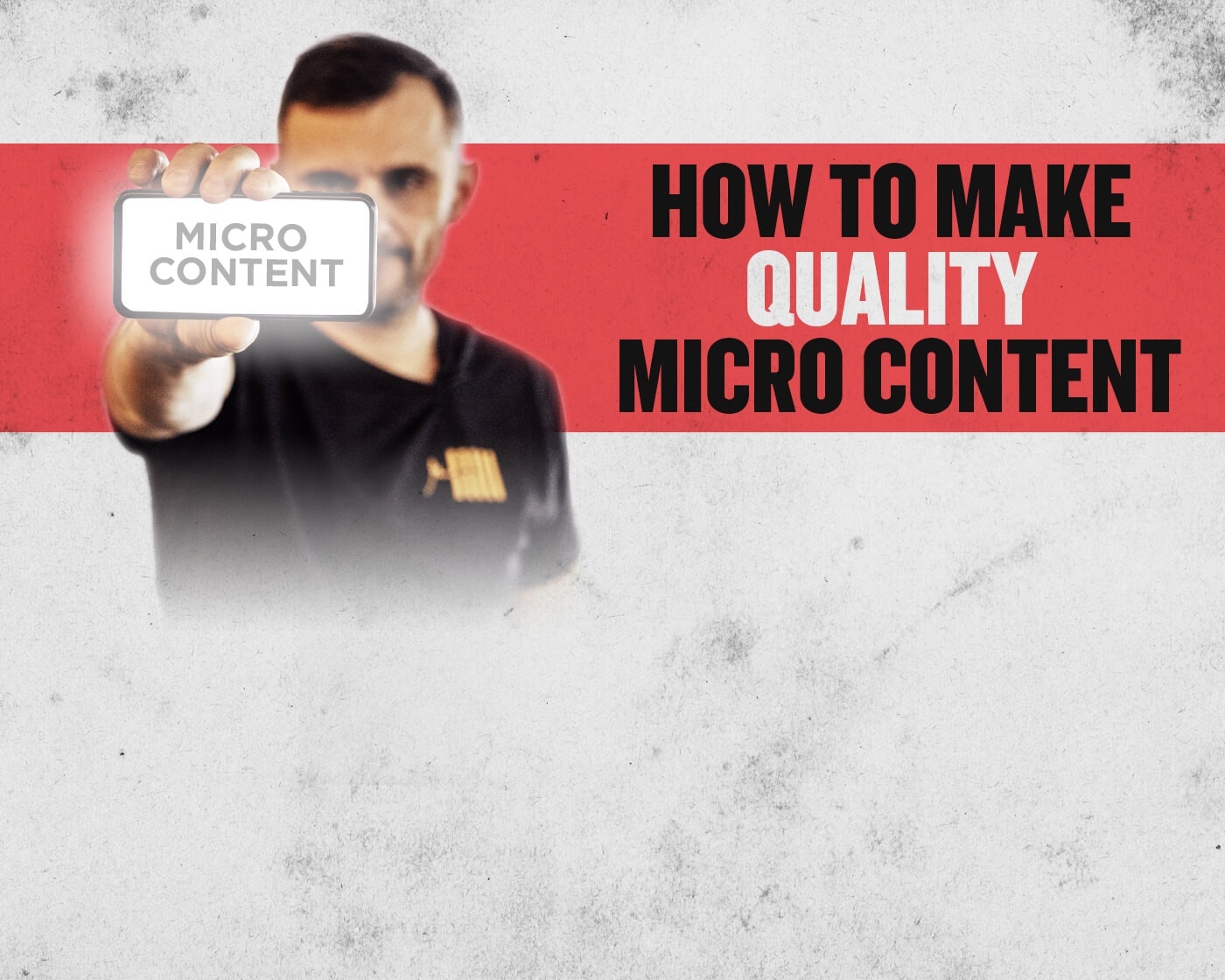The term “micro content” is something I started using three or four years ago. The notion was: content made specifically for the platform. You know, the videos, the pictures, the quotes, the written words that work on Facebook, Twitter, Tumblr, Pinterest, Instagram, Snapchat, and TikTok.
It was the context of the book, Jab Jab Jab Right Hook.
How You Can Create Good Micro Content
1. Quality Content Is Subjective
So, you want to know how to make good micro content and how to consistently get your team to do it? First of all, good content is subjective, right? Some people like Game of Thrones. Some people watch Game of Thrones and don’t like it (very few, I think, because it’s a very popular show) but you know it is still clearly subjective. That’s number one.
2. Your Team Will Learn Through Osmosis
Number two, once you get to a place where you can afford it, how do you get a team to start the process of creating micro-content for your or your brand?
When it comes to building the skills on a team, I wouldn’t say it’s about education.
I would say that, for me, scaling and getting my team to get there has a lot to do with what I call “osmosis.” That is, putting the knowledge into the “stream” versus making them attend a class.
Osmosis is also how you ensure your team is executing at the highest level from the top to the bottom – by letting them learn gradually from the environment and not being crippled when they’re “off” a little bit. For example, rather than over impose my will on creative output, I’ll let the market decide and let my employees learn from the outcome.
By the way, not everyone learns like me. My team and I wasted an enormous amount of time on senior people training junior people through osmosis. When we evolved into providing more products I realized, stuff (products, technology, services) to support people through a more structured learning process could be beneficial. Still, depending on the situation, I usually use osmosis.
3. Respect your audience
You’ve got to respect your audience. This means, you’ve got to respect the psychology of what they’re doing when they’re on the platform. I know a 40 year old woman has a different mindset when she’s on Facebook versus when she’s on Pinterest. That is what I keep in mind when I try to tell her a story, because I know I’m on Pinterest. On Pintrest, she has intent to shop and aspiration to shop. On Facebook, she’s keeping up with her world or consuming information. So I strategize around the psychology and the platform itself.
4. Make It About Them
When I say respect, I put out content that I think she will like versus what I’d like to accomplish. Yes, I’d like to sell rosé, but if I put it in a way that is more interesting to a mom, like five under $10 bottles of wine that help you unwind at the end of a full day with the kids, that would resonate better. Then you target eight-year-old kid moms.
Something like, 12 wines somebody who’s 38 will like and then targeting people that were born in 1982, could also work well. These are all strategies that will work. Add a very heavy Facebook or Instagram glamour’ shot of the wine at a nice angle. It’s that kind of stuff, stuff that’s cool and nice.
Respecting the audience, respecting the platform, and taking your agenda and making it third – that’s how you make great micro content.
That’s it for now! If you enjoyed that article it would mean a lot to me if you share it on Twitter.












Tham gia ngay Rbviet.net Rbesports để tận hưởng cá cược esports chuyên nghiệp, với hệ thống bảo mật hàng đầu, giao dịch siêu tốc và hàng loạt ưu đãi dành riêng cho bạn. – 2025 March 28, 17:30
Rayesports.com Rayesports mang đến hệ thống cá cược esports chuyên nghiệp, đảm bảo tính minh bạch, bảo mật cao cấp, hỗ trợ 24/7 và kèo cược hấp dẫn trên mọi tựa game hot. – 2025 April 05, 10:03
Rbviet.net Rbviet – Điểm đến lý tưởng cho cá cược thể thao điện tử, đảm bảo bảo mật cao, giao dịch nhanh và trải nghiệm đặt cược mượt mà trên mọi tựa game đình đám. – 2025 April 12, 09:18
Профессиональный сервисный центр по ремонту бытовой техники с выездом на дом.
Мы предлагаем:сервисные центры по ремонту техники в мск
Наши мастера оперативно устранят неисправности вашего устройства в сервисе или с выездом на дом!
Marka Danışmanlığı, Markanızın dijital dünyada güçlü bir temele sahip olması için ihtiyaç duyduğunuz her şeyi sağlıyoruz. Kullanıcı dostu, mobil uyumlu ve hızlı bir web sitesi tasarlıyor; aynı zamanda SEO, SSL güvenlik sertifikası ve çoklu dil desteğiyle global pazarda rekabet etmenizi kolaylaştırıyoruz.
في الختام، تعد عمليات التحقق عنصرًا أساسيًا في المراهنة عبر الإنترنت. نفذت 1xbet تدابير لضمان حماية المعلومات الشخصية والمالية للمستخدمين. من خلال تقديم المستندات المطلوبة والخضوع لعملية التحقق، يمكن للمستخدمين الاستمتاع بتجربة مراهنة آمنة ومأمونة. اختيار اللعبة هذه مقوله يكتبها العديد في المواقع الالكترونيه ويقولها العديد في الفيديوهات الخاصة بها لربح 500$ من خلال سكربت التفاحه فقط لجلب المزيد من المشاهدات ليس الا، ولكن لكي تعلم ماذا اقصد من كلامي اقرأ المقدمه التي وضعها اسفل هاذا المقال سوف تفهمك ماذا اقصد من كلامي.
https://junelbaucom.com/review-of-%d9%84%d8%b9%d8%a8%d8%a9-%d8%a7%d9%84%d8%b7%d9%8a%d8%a7%d8%b1%d8%a9-by-spribe-a-quick-guide-for-egyptian-players-on-1xbet/
لاستخدام تطبيق 1xbet للاندرويد، يجب أن يفي جهازك بمتطلبات معينة. وتشمل هذه: رغم أن هكر لعبة الطيارة 1xbet قد يوفر لك بعض المزايا المؤقتة، إلا أنه يمكن أن يؤثر سلبًا على تجربة اللعب بشكل عام. قد يؤدي ذلك إلى فقدان التحدي والمتعة التي تأتي مع اللعبة، مما يجعل التجربة أقل إثارة. تحميل برنامج 1xbet مهكر أو أي برنامج آخر مهكر بسبب أن هذا غير قانوني ويعتبر انتهاكا لحقوق الملكية الفكرية يجب علينا دعم العمل القانوني وعدم التورط في أي نشاط غير قانوني ينصح 1xbet تنزيل برنامج والتطبيقات من مصادر رسمية موثوقة وتجنب استخدام 1xbet تنزيل برنامج حيث قد تتسبب في تعريض جهازك للخطر وفقدان البيانات الشخصية أو المالية.